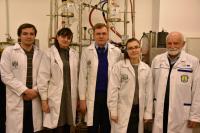Team of the Faculty of Chemistry recognized in the Student-Inventor Competition

The inventors include Michał Wrzecionek, Agnieszka Gadomska-Gajadhur, Ph.D., Eng., Paweł Ruśkowski, Ph.D., Eng., Monika Budnicka and Prof. Ludwik Synoradzki, Ph.D., D.Sc., Eng.; photo: BPI
A project entitled “Method of Manufacturing a Dynamic Spongy Bone Substitute and Related Solutions” impressed the judging panel of the 9th National Student-Inventor Competition promoted by the Kielce University of Technology.
The authors of the distinguished concept are Monika Budnicka (Ph.D. student), Joanna Trzaskowska (graduate), Aleksandra Kruk (Ph.D. student), Michał Wrzecionek (Ph.D. student), Monika Szymaniak (student) and Anna Tytman (student) as well as Agnieszka Gadomska-Gajadhur, Ph.D., Eng., Paweł Ruśkowski, Ph.D., Eng. and Prof. Ludwik Synoradzki, Ph.D., D.Sc., Eng.
Their substitute for spongy bone (which is the tissue filling the inside of bones and holding bone marrow, the outer layer of bones being cortical bone) is composed of an implant and plasma.
The implant looks like a piece of foam. “It is biodegradable, which means that it is expected to be gradually replaced by human tissue once implanted into spongy bone,” explains Monika Budnicka. “It is also intended as a carrier for platelet rich plasma, which is known to induce bone regeneration. Our implant is innovative insofar as it has very high porosity at over 90% and its inner morphology allows soaking in plasma.”
This is interesting inasmuch as, with all its advantages (such as being biodegradable and non-toxic), polylactide, which is one of the best known polymers, still has one fault impeding its application: it is hydrophobic or, in other words, it is repelled from substances such as water. And water is the main component of plasma.
“Our invention could help patients after bone resection, e.g. due to cancer or innate defects,” says Monika Budnicka. “This concept is designed to address critical defects, or those which do not heal naturally.”
***
This year’s Student-Inventor Competition has had 139 entries from 20 universities across Poland (the all-time high). The solutions entered are results of research and development efforts from teams of students, faculty and businesses. The number of contenders was 361, of which 157 were students.
The Student-Inventor Competition is open to students, Ph.D. students and university graduates who, during their course of study, have created or contributed to an invention or a utility model/industrial design protected by the exclusive right or being the subject of a patent application with the Patent Office of the Republic of Poland or the relevant intellectual property office abroad. Inventions and utility models created as part of international projects or contributed to by students of foreign universities are also accepted into the competition.
The main prize is a presentation and promotion of innovative solutions during the 47th International Exhibition of Inventions of Geneva. In addition, during their stay in Geneva, the winning students have an opportunity to promote their solutions and attend seminars of the World Intellectual Property Organization and the European Council for Nuclear Research. The winning solutions and those recognized with an honorary mention are presented at the 13th International Warsaw Invention Show, IWIS 2019.
More information about all this year’s winners and honorary mentions is available on the Kielce University of Technology website.







